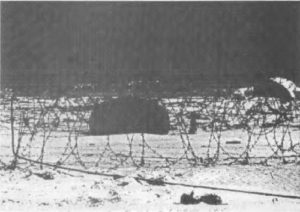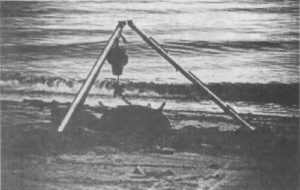- Author
- McConnochie, Ian, Lt Cdr, RAN
- Subjects
- History - post WWII
- Tags
-
- RAN Ships
- None noted.
- Publication
- June 1995 edition of the Naval Historical Review (all rights reserved)
During the period 27 January – 9 May, 1991, Australian Clearance Diving Team 3 deployed to the Middle East in support of Operations Damask and Desert Storm. Under the command of LCDR J. Griffith, RAN, the team consisted of 23 Clearance Divers and fifty tonnes of equipment and explosives and was initially based in Bahrain. In Bahrain the Team was involved in the preparations by the US Marine Corps for the potential amphibious invasion of Iraqi occupied Kuwait. As Operation Desert Storm progressed, for various reasons the requirement for an amphibious operation was negated. The Team’s primary mission as a consequence became the Explosive Ordnance Disposal (EOD) clearance of the ports of Kuwait in support of the US navy’s Coastal Warfare and Port Recovery operations.
March 1991 – Kuwait
In support of Coastal Warfare and Port Recovery operations CDT3 entered Kuwait by land on 5th March, 1991, to commence clearance operations with British and US Forces, their first objective being to clear the vital Kuwaiti port of Mina Ash Shuaibah 30 km south of Kuwait City. Shuaibah was Kuwait’s main port and the only port able to be used by the deep draught vessels required to bring food and water supplies into this devastated country. Speed therefore was of the utmost importance to allow humanitarian relief efforts to begin. Combining with almost 50 divers from the US and Royal Navies, CDT3 began the dangerous task of first clearing the wharves and warehouses of unexploded ordnance and booby traps before entering the black waters of the harbour itself, made treacherous by the thick crude oil and war wrecks, to search for and dispose of sea mines.

Upon completion of operations in Shuaibah the Team switched operations to the south and were tasked with a single force clearance of the Kuwaiti Naval Base Ras Al Qualai’ah and surrounding beaches. Over the next 10 days the Team cleared the heavily bombed naval facility of unexploded ordnance and booby traps, a task requiring 4 days before it was safe to move all equipment and personnel into the port to commence diving operations. CDT3 cleared 411,000 square metres of harbour bottom and rendered safe or destroyed an additional 31 sea mines.

April 1991
Coastal Warfare and Port Recovery operations were completed 22nd April, 1991 with the Team returning to Bahrain for well earned R and R and equipment maintenance and preparations for return to Australia on 11th May, 1991, after three and a half months deployed. CDT3 was disbanded on this date and members returned to their parent Teams.




